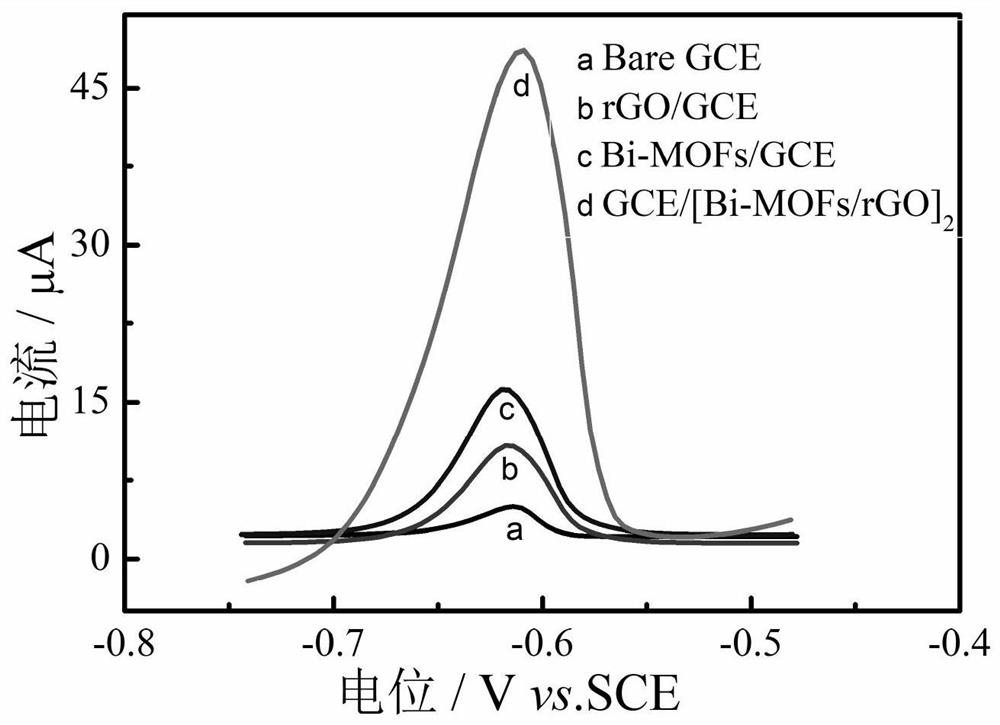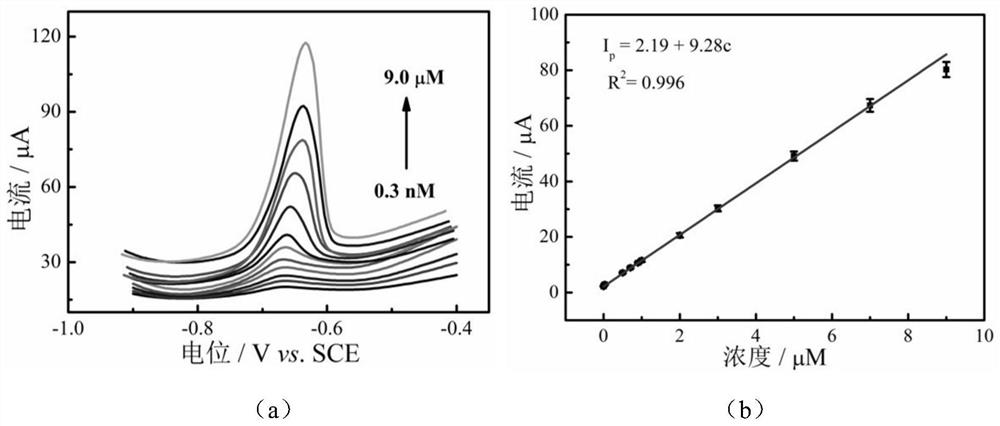An electrochemical sensor for detecting lead ions
A sensor and electrochemical technology, applied in the fields of electrochemical variables of materials, scientific instruments, instruments, etc., can solve the problems of low detection sensitivity of electrodes, limited electrocatalytic applications, and high cost of electrodes, and achieve strong selectivity, high sensitivity, and low cost. Effect
- Summary
- Abstract
- Description
- Claims
- Application Information
AI Technical Summary
Problems solved by technology
Method used
Image
Examples
Embodiment 1
[0034] Preparation of electrochemical sensors
[0035] 1. First, 0.15g Bi(NO) 3 ·5H 2 O and 0.75g H 3 BTC was added to the mixed solution of 60mL DMF and methanol. After sonication for 10 min, the mixture was sealed in a 100 mL Teflon-lined stainless steel autoclave and hydrothermally treated at 120 °C for 24 h. Then with DMF and CH 3 OH washed and centrifuged three times. After drying at 80 °C for 6 hours, Bi-MOFs were obtained.
[0036] 2. Preparation of GCE / [Bi-MOFs / GO]2: Disperse Bi-MOFs in DMF at a concentration of 0.5 mg mL -1 . GO was dispersed in DMF at a concentration of 1 mg mL -1 . 5 μL of Bi-MOFs solution was drop-coated on the surface of GCE, dried in an oven at 45 °C for 5 min, and then 5 μL of GO solution was dropped on the surface of GCE / Bi-MOFs. After drying, a Bi-MOFs / GO composite film was formed on the GCE. The above steps were repeated to obtain two-layer Bi-MOFs / GO composite modified GCE. Finally, the GCE / [Bi-MOFs / GO] 2 Reduction to get GCE / [B...
Embodiment 2
[0039] Detect the concentration of lead ions
[0040] Different concentrations (0.3nM, 7nM, 30nM, 0.5μM, 0.7μM, 0.9μM, 1μM, 2μM, 3μM, 5μM, 7μM, 9μM) of Pb 2+ The solution was added into the acetic acid buffer solution with a pH of 5.0, the electrochemical sensor prepared in Example 1 was connected to the test circuit, and the Pb was detected by differential pulse stripping voltammetry. 2+ Concentrations were measured as Pb 2+ Concentration is the abscissa (unit is μ M), is ordinate (unit is μ A) with stripping peak current value, establishes standard curve y=2.19+9.28x (R 2 = 0.996).
[0041] Such as image 3 As shown, the modified electrode on Pb 2+ have a good linear relationship (R 2 =0.996), and has a wide linear range (0.3nM-9.0μM) and high sensitivity and low detection limit (0.1nM), which fully demonstrates that the sensing electrode can successfully detect unknown concentrations of Pb 2+ .
[0042] Using rGO, Bi-MOFs modified glassy carbon electrodes (i.e. rGO / G...
PUM
| Property | Measurement | Unit |
|---|---|---|
| concentration | aaaaa | aaaaa |
| concentration | aaaaa | aaaaa |
Abstract
Description
Claims
Application Information
 Login to View More
Login to View More - R&D
- Intellectual Property
- Life Sciences
- Materials
- Tech Scout
- Unparalleled Data Quality
- Higher Quality Content
- 60% Fewer Hallucinations
Browse by: Latest US Patents, China's latest patents, Technical Efficacy Thesaurus, Application Domain, Technology Topic, Popular Technical Reports.
© 2025 PatSnap. All rights reserved.Legal|Privacy policy|Modern Slavery Act Transparency Statement|Sitemap|About US| Contact US: help@patsnap.com



